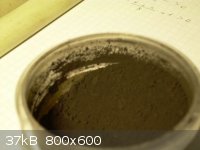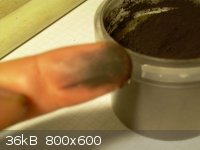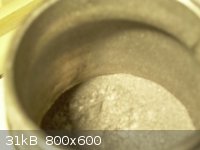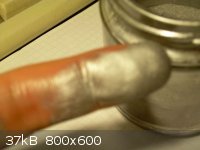labworm
Harmless

Posts: 1
Registered: 26-8-2011
Member Is Offline
Mood: No Mood
|
|
Thermite problem
I've tried to make thermite, using a VERY fine aluminium powder (unknow mesh) and an similary fine iron oxide powder. Those materials come from
painting industry and I think too fine to made thermite.
I've mixed it with a 1/3 weight ratio for Al/oxide (it's Stoichiometric ratio) and ignited with a magnesium wire.
The mix ignite and burn but producing just some brown dust, not melted iron, as expected.
Maybe the aluminium/oxide dust are too fine ?
What about your experience ?
Attach some image
   
|
|
|
Megamarko94
Hazard to Self
 
Posts: 68
Registered: 31-12-2010
Member Is Offline
Mood: No Mood
|
|
smaller size of particles better and faster they react..
[Edited on 26-8-2011 by Megamarko94]
|
|
|
redox
Hazard to Others
  
Posts: 268
Registered: 22-2-2011
Location: The Land of Milk and Honey
Member Is Offline
Mood: Chalcogenetic
|
|
Quote: Originally posted by labworm  | I've tried to make thermite, using a VERY fine aluminium powder (unknow mesh) and an similary fine iron oxide powder. Those materials come from
painting industry and I think too fine to made thermite.
I've mixed it with a 1/3 weight ratio for Al/oxide (it's Stoichiometric ratio) and ignited with a magnesium wire.
The mix ignite and burn but producing just some brown dust, not melted iron, as expected.
Maybe the aluminium/oxide dust are too fine ?
What about your experience ?
Attach some image
|
What was your batch size? I have found from multiple thermite experiments that sometimes if the total weight is too low, then the globules don't
coalesce.
My quite small but growing Youtube Channel: http://www.youtube.com/user/RealChemLabs
Newest video: Synthesis of Chloroform
The difference between chemists and chemical engineers: Chemists use test tubes, chemical engineers use buckets. |
|
|
dangerous amateur
Hazard to Others
  
Posts: 144
Registered: 8-7-2011
Member Is Offline
Mood: No Mood
|
|
Seems like it's burning so fast that the reagents are thrown around before they can react.
Your Aluminium seems to be "Aluminium Bright".
IMHO it's to fine to make thermite, it burns to fast.
You should use atomized or granulated aluminium >100µm.
|
|
|
nitro-genes
International Hazard
    
Posts: 1048
Registered: 5-4-2005
Member Is Offline
|
|
Your aluminium looks like pretty fine flake, which is really reactive. I remember making thermite the first time with ballmilled Iron oxide and 600
mesh flake Al, it behaved more like flashpowder than regular thermite.  50
micron, spherical (Atomized) aluminum gives much better results... 50
micron, spherical (Atomized) aluminum gives much better results...
[Edited on 27-8-2011 by nitro-genes]
|
|
|
Microtek
National Hazard
   
Posts: 827
Registered: 23-9-2002
Member Is Offline
Mood: No Mood
|
|
IMO, there isn't much of an advantage to using very fine reagents for thermite. In fact, one can advantageously use a "priming" mixture of relatively
fine reagents (just fine enough to be ignited reliably) and then a main load of very coarse reagents (a grain size of several millimeters is fine).
The thinking is that the Al and oxide react in the liquid phase so, as long as the priming mix produces enough heat to melt some of the main load, the
reaction heat will take care of the rest.
The low reaction rate means that there is time for the reaction to do useful work, rather than just scattering hot products everywhere.
|
|
|
tang powder
Harmless

Posts: 2
Registered: 8-9-2011
Location: rio de Janeiro
Member Is Offline
Mood: No Mood
|
|
im thinking a powder obtained at painting grade might be cut with non-reacting ingredients?
a thermite should burn itself into heat and smoke...the residue might be unreacted filler from the powdered metals.
aluminum shavings and coarse iron oxide will make for a violent thermite, the fine powder may be hindering the aluminum's ability to reduce the oxide
and freely generate heat, if not enough aluminum oxide, iron and heat can be made. the result is unreacted ingredients.
are the ingredients still reactive? if not... i think its just inert filler.
|
|
|
bdbstone
Harmless

Posts: 18
Registered: 23-4-2011
Member Is Offline
Mood: No Mood
|
|
Painting powdered al. is too fine, producess too quick so it doesn't produced temperatures you will expect from the thermite reaction. Be carefull
with fine powder aluminium, cause with right metal oxide can combust as flash powder or even explosively.. I heared sulphates-thermite produced
especially quick and some other metal oxides like CuO can combust explosivelly when mixed with very fine al.powder.
Its crucial the reaction doesn't produces too quickly(and doesn't stop either). Maybe mixing chunks you will get from fileing al. and fine powder,
just to get the reaction going and doesn't stop. You will have to practice.
[Edited on 9-9-2011 by bdbstone]
|
|
|
atomicfire
Harmless

Posts: 37
Registered: 7-2-2011
Member Is Offline
Mood: shaprening my molecular scissors
|
|
I've used a 7/3 ratio (700g iron powder and 300g aluminum) and I get pretty molten ironglobs out of that.
ban DHMO
|
|
|
elementcollector1
International Hazard
    
Posts: 2684
Registered: 28-12-2011
Location: The Known Universe
Member Is Offline
Mood: Molten
|
|
I've tried a few mixes of 8g Fe2O3 (lab grade) and 3g Al (home-made). They don't burn at all, not even with KMnO4 + glycerin, that with magnesium,
that with an additional aluminum/sulfur charge... What am I doing wrong? This stuff just refuses to ignite, no matter how small the particle size is!
Elements Collected:52/87
Latest Acquired: Cl
Next in Line: Nd
|
|
|
chemcam
Hazard to Others
  
Posts: 423
Registered: 18-2-2013
Location: Atlantis
Member Is Offline
Mood: I will be gone until mid-september, on a work contract.
|
|
When you put flame to the aluminum by itself does it ignite very bright white?
|
|
|
elementcollector1
International Hazard
    
Posts: 2684
Registered: 28-12-2011
Location: The Known Universe
Member Is Offline
Mood: Molten
|
|
It sends off yellow-white sparks, but I don't think it burns by itself.
Elements Collected:52/87
Latest Acquired: Cl
Next in Line: Nd
|
|
|
hyfalcon
International Hazard
    
Posts: 1003
Registered: 29-3-2012
Member Is Offline
Mood: No Mood
|
|
Wrong iron oxide. I've seen three types; black, red, and yellow. Black and red works in thermite. Yellow doesn't. All it's good for is a nice tan
color in your concrete stain.
|
|
|
elementcollector1
International Hazard
    
Posts: 2684
Registered: 28-12-2011
Location: The Known Universe
Member Is Offline
Mood: Molten
|
|
Using the red type. It's fairly fine already, not on the level of powder but more like extremely small granules/crystals. Difficult, but not
impossible to grind into powder with a mortar and pestle.
(I was using a yellowish-orange type before, thanks for letting me know.)
Elements Collected:52/87
Latest Acquired: Cl
Next in Line: Nd
|
|
|
Fantasma4500
International Hazard
    
Posts: 1677
Registered: 12-12-2012
Location: Dysrope (aka europe)
Member Is Offline
Mood: dangerously practical
|
|
i know this type of aluminium, aluminium bright as stated earlier.. it has a sweet smell (or well usually)
its pretty much around 325 mesh
it cannot be too fine to react.. trust me
the wax coating on the aluminium can be the problem and you need to start the reaction perhaps at the core, also using too little thermite might ruin
it all aswell
let me pull up a video where iron oxide and german dark aluminium is being used (german dark = 1-3µm)
http://www.youtube.com/watch?v=QxnTpcCQCdM
im not 100% sure but i believe hes just using standard 2mm visco to ignite this thing?
anyways if you fail to ignite it, make a piece of rocket candy and put it into the whole thing along with a fuse taped to it or whatever.. should be
enough..
also if its black iron oxide (Fe3O4) you have then you can convert it into Fe2O3 by reacting it with air, as in... heat the thing up in a can over a
flame or whatever, and you can speed this up if you take a long tube and blow air into it.. before you do this you might wanna consider how messy
finely powdered metaloxides really are
hint: alot.
|
|
|
elementcollector1
International Hazard
    
Posts: 2684
Registered: 28-12-2011
Location: The Known Universe
Member Is Offline
Mood: Molten
|
|
Isn't there a way to take the wax off? Boiling in xylene or some such?
Elements Collected:52/87
Latest Acquired: Cl
Next in Line: Nd
|
|
|
Fantasma4500
International Hazard
    
Posts: 1677
Registered: 12-12-2012
Location: Dysrope (aka europe)
Member Is Offline
Mood: dangerously practical
|
|
plausible.. dont know what type wax.. im not sure if its candle wax they use for it.. you would need to put some charcoal over it when its done tho,
in order to keep it from reacting with the air..
also.. correction.. he used 'paint grade' al 70 micron (200 mesh or what?)
he put a little pile of GD Al on top, which the fuse ignited, and then ignited the thermite
|
|
|
Dornier 335A
Hazard to Others
  
Posts: 231
Registered: 10-5-2013
Location: Northern Europe
Member Is Offline
Mood: No Mood
|
|
I suggest that you grind your Fe2O3 if it's granular. You could ball mill it if you have one. How fine is your aluminium? And is it coated or not?
Thermite with Al over 50 micron is quite hard to light but it should be possible with both magnesium ribbon and Al/S mixture.
Antiswat:
Metal powders are usually coated in stearic acid. It should be possible to wash it off with propanol.
|
|
|
chemcam
Hazard to Others
  
Posts: 423
Registered: 18-2-2013
Location: Atlantis
Member Is Offline
Mood: I will be gone until mid-september, on a work contract.
|
|
Does it not ruin your mortar and pestle? I thought grinding metal would scratch the hell out of it and make little crevasses for stuff to get stuck
in.. Is this not true?
|
|
|
Fantasma4500
International Hazard
    
Posts: 1677
Registered: 12-12-2012
Location: Dysrope (aka europe)
Member Is Offline
Mood: dangerously practical
|
|
Quote: Originally posted by chemcam  |
Does it not ruin your mortar and pestle? I thought grinding metal would scratch the hell out of it and make little crevasses for stuff to get stuck
in.. Is this not true? |
iron oxide stains is very very easily removed by rubbing your mortar into CuO powder / slurry and then adding HCl
it gets more clean than when it was new really..
|
|
|
elementcollector1
International Hazard
    
Posts: 2684
Registered: 28-12-2011
Location: The Known Universe
Member Is Offline
Mood: Molten
|
|
I'll list sources for everything, in case someone can point to the problem (though I'm pretty sure it's the Al).
Fe2O3: Reagent grade, Caroline Labs (don't recall exact name), dark red granular powder
Al: A mix of Reynold's brand Al foil (powdered) and machine-shop recycled Al (shredded). The stuff from the machine shop had a faint smell of oil, and
does not seem to powder all the way (though more testing is required).
KMnO4: 4 oz. bottle, Elemental Scientific. Reagent grade, very dark purple powder (actually just very small crystals).
Glycerin: Random store in California, apparently used as a dermal health item.
Mg ribbon: 3' ribbon, Elemental Scientific. Surface tarnish from accidentally leaving it outside; appears to be easily removed with sandpaper. Burns
brightly.
Notes:
-KMnO4 + glycerin does not always burn, though it always smokes and produces a charred crust of MnO2. My current ratio is about a quarter teaspoon
KMnO4 to 2 drops glycerin (horribly inaccurate, I know, but this is from memory). Does not ignite Mg ribbon.
-When heated with a blowtorch to red-heat, small sparks are given off for a short while in the particular area of the powdered mix, and on one case it
appeared that a small portion of the thermite did ignite (though the rest did not).
-The method for ignition I always try is to pile up the powder into a small mound in the middle of a bed of sand, then make a small crater in the top
with the back end of a disposable plastic pipette, then pour the KMnO4 in until it just about fills up the crater, then put the Mg ribbon as far in as
possible, and then add two drops of glycerin as close to the Mg ribbon as possible. Never ignited the Mg.
-My glycerin is an extremely viscous fluid that takes forever to even go up a pipet, and sometimes won't for the thinner-necked ones.
-The Al was created by first placing the machine-shop Al bits in a coffee grinder, making flakes about 3mm-4mm square. To this was added some Al
powder that was made from foil (very dark gray, not at all metallic in appearance), and this was ball-milled for roughly a week. This was sifted and
used (the Al now contained small amounts of shinier specks, from the machine-shop stuff).
-The Fe2O3 was prepared by grinding it multiple times in a mortar and pestle, sifting the result every so often. Once this was a fine powder that
passed completely through the sieve (holes ~1mm diameter), it was given a final round with the mortar and pestle and used.
-The Fe2O3:Al mix was kept close to the standard stoichiometric ratio of 8:3(+/- 0.1g), with adjustments sometimes for excess of one reagent (ex:
10.3g:3.9g).
That's as much as I can think of - hopefully an experienced Goldschmidt-enthusiast can comb through this and find the problem(s).
EDIT: http://www.youtube.com/watch?v=xaF0i0qLyuI
That shiny Al looks tempting - but he claims to 'burn' the stuff after the first blend in ethanol.
Now, I'm no genius, but wouldn't the Al just oxidise to death? The better solution would be to *boil* the ethanol/aluminum slurry, to dissolve the
plastic coating (and possibly clean the aluminum to acceptable levels).
Given that I have isopropanol and the powdered foil (looks the same gray as his does before the 'burning'), I'll be sure to give this a try. If that
doesn't work, I'll try it with denatured alcohol.
[Edited on 20-5-2013 by elementcollector1]
Elements Collected:52/87
Latest Acquired: Cl
Next in Line: Nd
|
|
|
elementcollector1
International Hazard
    
Posts: 2684
Registered: 28-12-2011
Location: The Known Universe
Member Is Offline
Mood: Molten
|
|
I'm glad to note that my thermite succeeded - even in the rain!
I ended up using potassium permanganate/glycerin, but tried magnesium ribbon, which never even reached the thermite (burned out halfway through - ???)
and sulfur/aluminum, which got mixed in (so now the iron lump smells of H2S...)
But the important thing is, it worked.
Elements Collected:52/87
Latest Acquired: Cl
Next in Line: Nd
|
|
|
Fantasma4500
International Hazard
    
Posts: 1677
Registered: 12-12-2012
Location: Dysrope (aka europe)
Member Is Offline
Mood: dangerously practical
|
|
Quote: Originally posted by elementcollector1  |
Al: A mix of Reynold's brand Al foil (powdered) and machine-shop recycled Al (shredded). The stuff from the machine shop had a faint smell of oil, and
does not seem to powder all the way (though more testing is required).
[Edited on 20-5-2013 by elementcollector1] |
well.. from a machine shop..? amazing that you got that to work.. i doubt thats of very fine mesh really..
or perhaps if they get the powder from something alike P1000 sandpaper it could make sense using it but if not then it seems senseless to me trying to
use it for thermite..
i found in another thread that acetone can be used to wash away the wax coating, cant remember which one, it was just mentioned as a procedure to make
the aluminium more useful tho
you could try a low mesh magnalium instead (which shouldnt be too hard to produce..)
|
|
|
elementcollector1
International Hazard
    
Posts: 2684
Registered: 28-12-2011
Location: The Known Universe
Member Is Offline
Mood: Molten
|
|
I used a coffee grinder and ball mill on the stuff - works fine.
Magnalium would require melting one of the two elements, which is not possible for me unless I have a pretty good coal setup going. Maybe sometime in
the far-off future.
Elements Collected:52/87
Latest Acquired: Cl
Next in Line: Nd
|
|
|